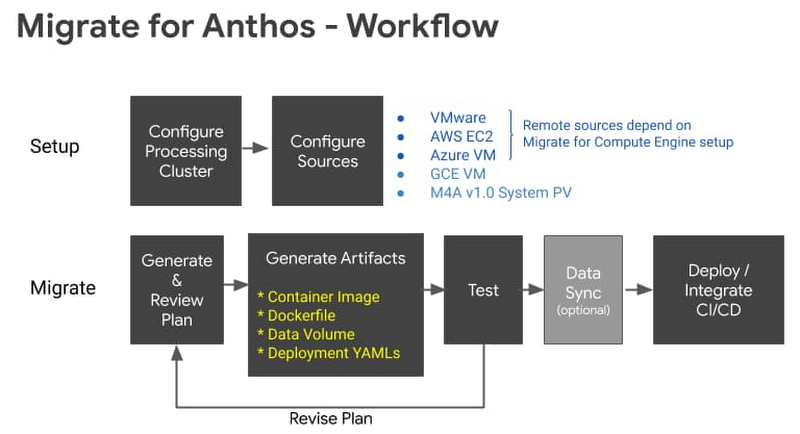App modernization with Migrate for Anthos: now supporting day-two ops
Issy Ben-Shaul
Director of Engineering, Google Cloud
Tom Nikl
Senior Product Marketing Manager, Cloud Migration
Not all application modernization strategies are created equal. One of the simplest approaches is to take an existing virtual machine and save it as a container. But while the resulting container will work, it won’t give you the benefits of more sophisticated modernization techniques—both in terms of resource utilization, or the advanced “day-two operations” made possible by running on an advanced container management platform like Anthos GKE.
Today we announced several new updates for Anthos including the latest release of Migrate for Anthos. Our automated containerization solution now includes enhanced VM-to-container conversion capabilities that can help you modernize your legacy workloads into Kubernetes and Anthos. It’s also tightly integrated with Anthos Service Mesh, supports Anthos running on-premises, and can convert legacy Windows Server applications into containers.
Beyond lift and shift with images
Earlier versions of Migrate for Anthos took a “lift and shift” approach to containerization. It extracted the workloads from the virtual machine (while leaving out the operating system kernel and VM-related components) and converted them into stateful containers. It also added a runtime layer that integrated the workloads with Kubernetes storage, networking and monitoring.
With this new release, Migrate for Anthos now dissects the contents of a VM and generates a suggested breakdown of its content into image and data components. These can be reviewed and tested, and generates all the artifacts you need to perform container image-based management: Docker image, Dockerfile, Deployment YAMLs and a consolidated data volume, which can be any type of Kubernetes-supported storage. The modernization process itself is elegantly orchestrated by Kubernetes building blocks (CRDs, CLI) and mechanisms, as described in this video and diagram.


This image-based approach allows you to harness the modern CI/CD pipeline tools to build, test, and deploy applications, as well as leverage Kubernetes for consistent and efficient deployment and roll out of new images across your Kubernetes deployments, including clusters, multi-clusters and multiple clouds.
In addition to enabling a modern developer experience, the image-based solution unlocks the power of the Kubernetes control plane and its declarative API for further operational efficiencies. For instance, with application components that are stateless in nature, you can implement load balancing, dynamic scaling and self healing without having to re-write the application.
This means that Migrate for Anthos is now tightly integrated with Anthos Service Mesh, bringing the benefits of enhanced observability, security, and automated network policy management to legacy applications—again, without changing the application code. The containerization technology in Migrate for Anthos 1.3 is GA for Anthos on Google Cloud. But, for organizations that want to modernize their workloads to Anthos, but aren’t ready to move these workloads to Google Cloud yet, Migrate for Anthos 1.3 also includes a preview that supports Anthos GKE running on-prem.
One of our partners, Arctiq, is actively using Migrate for Anthos and says it is helping them transform their customers’ operations:
"Migrate for Anthos is a uniquely powerful way to modernize your existing virtual machines into containers running in Google Kubernetes Engine,” said Kyle Bassett, Partner at Arctiq. “Traditionally, converting these VMs into containers was laborious and required a deep knowledge of Kubernetes, so most customers just left their VMs alone. But with Migrate for Anthos, you can extract workloads out of VMs and get them running on containers using a more automated and reliable workflow. Leveraging Migrate for Anthos, Arctiq is able to assist our customers increase their workloads’ performance while reducing their infrastructure and management costs."
Automated containerization for Windows servers
Earlier this year, we announced you could now run Windows Server containers on GKE. However, because this is still an emerging technology, there aren’t many native Windows containers yet, and manually containerizing a Windows application can be challenging.
With Migrate for Anthos, you can now convert legacy Windows server apps into Windows Server 2019 containers and run them on GKE in Google Cloud . This includes Windows 2008 R2, which recently reached end-of-support from Microsoft. This feature is available in preview and includes fully automated discovery and assessment tooling.
This lets you automatically convert IIS, ASP.NET based apps running on Google Compute Engine VMs, which helps you reduce infrastructure and licensing costs. For IIS and ASP.NET apps that run on-premises or on other clouds, you can first use Migrate for Compute Engine to move them into Compute Engine VMs, then use Migrate for Anthos to convert them into containers. Support for non IIS and ASP.NET apps is forthcoming.
Another alternative is to migrate only parts of an application stack to Windows containers. That way, elements that can’t easily be migrated to containers can run in Compute Engine VMs and still leverage VPC-level networking integration with containers on GKE.
Accelerate your modernization
Almost every customer we talk to tells us that they want to use more containers. Migrate for Anthos can help you accelerate that process by reducing the time and effort that exist with alternative processes. If you’re interested in participating in these or upcoming Migrate for Anthos previews, please fill out this form and mention “Migrate for Anthos” in the ‘Your Project’ field.
